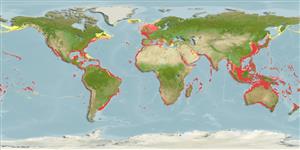Common names from other countries
Environment: milieu / climate zone / depth range / distribution range
Ecologia
Pelágico(a,os,as); intervalo de profundidade 0 - 200 m (Ref. 83938). Tropical; 50°N - 42°S, 180°W - 180°E (Ref. 275)
Circumglobal in tropical and warm temperate seas.
Length at first maturity / Tamanho / Peso / Idade
Maturity: Lm ? range ? - ? cm Max length : 72.6 cm TL (female)
Maximum total length: male, 1.5 to 2.0 cm. Maximum length of shell, 30 cm in females; males are of dwarf size, only 1.5 to 2 cm in total length (Ref. 275). Maximum total length 72.6 cm, and mantle length 14.14 cm for females (122434). Epipelagic (Ref. 83938). Females use the shell to trap air, gathered at the sea surface, to attain neutral bouyancy (Ref. 96968). Few shells found washed up on beaches (Ref. 88739).
Life cycle and mating behavior
Maturidade | Reprodução | Desova | Ovos | Fecundidade | Larvas
On contact with the female, it is presumed that the male autotomizes the hectocotylus. Multiple hectocotyli can persist in shells and mantle cavities of females for extended periods. Eggs of up to five different developmental stages may be present within a single shell (Ref. 96968). Females inhabit the shell of Nautilus for egg deposition and brooding (Ref. 98241).
Roper, C.F.E., M.J. Sweeney and C.E. Nauen. 1984. (Ref. 275)
Status na Lista Vermelha da IUCN (Ref. 130435)
Status no CITES (Ref. 108899)
Not Evaluated
Not Evaluated
Uso pelos humanos
Pescarias: espécies comerciais
| FishSource |
Ferramentas
Mais informação
Idade/TamanhoCrescimentoComprimento-pesoComprimento-comprimentoMorfologiaLarvasAbundância
Fontes da internet
Estimates based on models
Preferred temperature
(Ref.
115969): 13.6 - 27.8, mean 23.8 (based on 1594 cells).
Vulnerabilidade
Low vulnerability (10 of 100).
Categoria de preço
Unknown.
